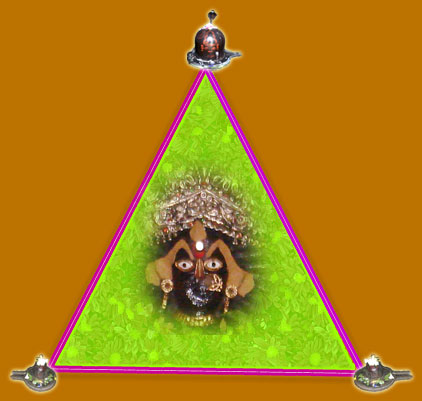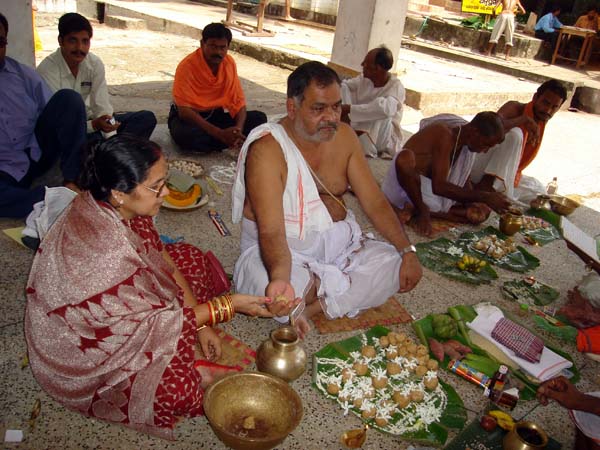No historical record is available about the pristine glory of the great mother goddess Biraja before the great epic the Mahābhārata was written. There is a reference to Virajāh-Tīrtha in the Vanaparva of the Mahābhārata in chapter 85. Moreover the said epic reiterates that the Virajāh-Tīrtha was a sacred place for Vedic sacrifices where Dharma, the God of Righteousness had performed a great sacrifice. During the performance of sacrifice Rudra -Siva is said to have been accepted as an Āryān God by other Gods and the mother Earth had appeared in the form of altar. Therefore, it is but natural that the goddess Earth was worshipped as goddess Biraja of the Virajāh-Tīrtha, Later on. The Ṛgvedic earth goddess was a vaishnavite deity and so became goddess Biraja of the Virajāh-Tīrtha. The Mahābhārata is as old as 7th-6th century B.C. as determined by the scholars. The historicity of goddess Biraja goes back to the days Mother Goddess worship of the Atharva Vedic period i.e. 13th century B.C.
She was originally worshipped in the form of an altar and later on in the form of Stambhesvari (pillar Goddess) as was the primitive practice when carving of stone; metal or wooden images were yet to come about. Most probably she was vindhyavāsinī and Biraja as they named her. During the Gupta rule in India in the 4th century AD, Goddess Biraja was metamorphosed in the theriomorphic form and a stone image of two-armed Mahisāmardinī was installed in a temple after a great Vedic sacrifice beside the river Vaitaraṇī.

Since then she is being worshipped on the pedestal as the symbol of paramavaiṣnavī Śakti icon. Simultaneously Nābhigayā, a great Pitṛ Tīrtha, Īśānesvara, lord Varāha and many ancillary deities were added to the Biraja tradition. We are apprised of her greatness from several copper plate grants of Durjaya, Vigraha, Dutta and Maṇa royal dynasties who patronised and revered the deity. During Bhaumakara rule in Odisha she was worshipped as the royal Goddess of the Bhaumakaras. During the Somavansi rule in the 10th -11th century AD, a beautiful temple for Goddess Biraja had been built by Candihār Yayati II. Biraja Kṣetra was made a full-fledged Śakti pīṭha with the association of Aṣṭa Candī, Aṣṭa-Bhairava, Navadurgā, Sapta Matṛkā, Trayodaśa Rudra, Dvādaśa Gaṇeśa, Sixty eight Tīrthas and Causaṭhi Yoginī during Bhaumakara and Somavamsi period. The Somavamsis added a car festival or Rathayātrā with the Biraja tradition like that of the Goddess Vindhyavāsini and Sthambhesvarī of mid-India. Though during the Mughal Afghan rule the Śakti worship relating to Goddess Biraja faced the ups and downs, the tradition continues undeterred till today.
Puranic Account of Goddess Biraja

Biraja Kṣetra Jajpur, the sacred abode of Goddess Biraja registered its importance as a prominent seat of Śakti worship since the prehistoric period. Goddess Biraja, the presiding deity of Jajpur has glorious antiquity. She is perhaps the most ancient Goddess, the Śakti or primordial energy incarnate of the Hindu pantheon, Goddess Biraja is worshipped and adored not only as Ādiśkti or primeval power but forms an integral part of the social, religious and cultural life of the people of Odisha. The glory of Goddess Biraja has been endorsed in various texts starting from the age of the epics, purāṇas, Sthalamahātmyas and Tantric works. The Biraja Kṣetra mahātmya, which is considered as a part of Brahmaṇḍa purāṇa enumerates the origin of Goddess Biraja.
It states that the days of yoke Brahma (the creator of the Universe) performed a yajna or Vedic sacrifice on the bank of the sacred river Vaitaraṇī. At the invocation of Brahma, Goddess Parvati or the AdiŚakti emerged out of the Garhapatya fire of the sacrificial pit. Being move by her prayers, Parvati instructed Brahma to name her as Biraja. She appeared in the form of two armed Mahiṣāmardinī tramphing on the neck of the theriomorphic form of the buffalo demon and piercing the trident into his body politic. She was entreated by Brahma to glorify the Kṣetra by her presence as the devine consort of Siva. When she occupied her position the circum centre of the triangular Kṣetra (region), Nine Durgās, Eight Candikās, and Sixty four Yoginīs were created from her mind and their pervading presence made this land a unique Śakti Kṣetra in the country.
The perimeter of the Biraja Kṣetra is triangular in form. The apex of the triangular region or the extreme points extends in the western, South-eastern and North-eastern by direction and those corners are guarded by the Siva lingams like Uttarsvar/Vilvesvara, Varuṇesvara and Kilalatesvara respectively. They are regarded as the guardian deities of the Kṣetra. The presiding deity goddess Biraja adored the cicumcentre of this triangular region.
In the medieval period almost all the ancient Tirthas were converted into pīṭhas in the name of some Gods or Goddesses and so became the abode of Goddess Biraja. Therefore Biraja Tīrtha and Biraja Kṣetra became famous as Biraja pīṭha. Pīṭha has a Tantric commotation of a place where an sādhaka achieves his goal through penance, austerities and Tantric rites near the presiding Goddess, from the Dakṣa-yajna-vidhvamsana-prakaraṇa of Kālikā purāṇa, it is known that the places where the limbs of Sati, the consort of Siva fell were called Śākta-pīṭhas, or the holy seats of mother Goddess. According to this tradition the ‘Navel’ of sati fell at Biraja Kṣetra and this place became known as Nabhipīṭha or Nābhigayā in the tantric tradition. So Goddess Biraja is regarded as the pīṭha Devi of this Śakti pīṭha.


The tantric texts contain the names of such pīṭhas with pīṭha Devis. The Biraja pīṭha is mentioned in the ‘pīṭhanirṇaya’ which mentions fifty one pīṭhas along with pīṭha Devis and Bhairavas accompanying them. From the tantric texts it appears that Biraja pīṭha was a great śākta pīṭha and goddess Biraja has been adored as the pīṭha Devi of Odisha with lord Jagannāth as Bhairava, Tantric texts like Hevajra tantra, Kālikā purāṇa, Rudrayāmaḷa Tantra, Aṣṭadasa pīṭha, Kubjikā Tantra, Tantrasāra, Jñānārṇava tantra, Tantra Cudāmaṇi, Uddīyāṇa Tantra, Candīmangaḷa, Brihannila Tantra, praṇatosiṇī tantra etc, mention about Biraja pīṭha too. The Buddhist work named Daṭhadhatuvamsa mentions about Biraja pīṭha also.
According to puranic tradition Goddess Biraja is described as ‘Pitṛīkanya’ or the mental child of the ancestral mānas, keeping the line of this tradition Vāyu purāṇa and viṣṇu purāṇa state that Biraja is the mental child of Ājyapā pitṛgaṇas i.e.-
This kind of description is found in Brahma purāṇa and Linga purāṇa etc. therefore the Hindu devotees from various parts of the country come over here to offer piṇḍas or oblations to their ancestors in the mṛtyunjaya Tīrtha near Nābhigayā and have a Darsan of Goddess Biraja.
Visitors & Tourists
Jajpur is an important tourist spot in Odisha. Not only religious people but also researchers, political people and general tourists come over here form the time immemorial. We have no detailed records of the past but it is of course, known form history and traditions that many people visited Goddess Biraja and Jajpur in the past.
As Jajpur or ancient Biraja was the capital of different ruling dynasties, the kings and emperors might be visiting Goddess Biraja during their tenure. The literary account conveys that the great Nātha teachers like Matsyendranāth and Birupakshnāth had visited Goddess Biraja. The Bhaumakara rulers are known to have been the devotees of goddess Biraja .They were having darsan of the Goddess almost daily.Padmasambhava a Buddhist monk had attained Siddhi (fulfillment of desire) after penance near Goddess Biraja. Sri Chaitanya (1510 AD) a great saint and seer had visited Goddess Biraja during his visit to Jajpur. Guru Nanak (1506 AD) is said to have visited the temple during his travel from Bengal to Puri. Yayāti Keshari of the soma dynasty was a great devotee of Goddess Biraja and was the son of the soil. There is a legend that Yayāti Keshari was residing inside the temple premises before his coronation to the throne. Padmapadācārya (the then Sankarācārya of Govardhan Pīṭha, Puri) had become his advisor for constructing a temple for lord Jagannath and converting Jajpur to a Saiva Kṣetra.
During the Ganga and Gajapati rule Chodaganga Dev and Pratāparudra Dev might have visited Biraja temple as we come across an inscription of Chodagangadeva here and construction of Sri Varāha temple by Pratāprudradeva at Jajpur. Since the time of Yayāti Keshari there was a tradition of the meeting of Gajapati king of puri and Sankarācharya of Puri on the Hera Panchami day during car festival at Puri in the Biraja temple Primises.The tradition has since been discontinued .The marhatās were great builders and revivalists of Hindu temples at Jajpur. Raghuji Bhonsale, the marhatā subedār is believed to have visited the Biraja temple during the 18th Century AD. Many Saints and Seers like Achyutānanda Dās and Bāyā bābā are known to have visited the Biraja Shrine. Mere over during the British Period and Post-independence period many scholars like C.S. Banerjee, Bankim Chandra , Radharaman Das, Armustrong, Markham Kettoe, Thomas Motte, John Lekie, Durati Barbosa. R.D. Banerjee, M.M Ganguly, R.L. Mitra, N.N. Vasu, D.C. Sircar and K.C. Pānigrāhī have visited the Biraja Shrine.It is a legend that the king of Nepal had also visited Goddess Biraja. Above all many unnamed visitors from far and near visit Goddess and offer piṇḍas to their ancestors near Nābhigayā, through the centuries past.




His Holiness Jagatguru Sankaracharya of Govardhan Math of Puri visited the Maa Biraja Temple on-25.04.2012 and performed puja and obtained the blessings of Maa Biraja.

Sri Ramroop Jaganath, a Mauritian citizen of Jajpur origin had finally searched his ancestral home at Nuagaan under Korai Block and reached Maa Biraja Temple on-08-12-2012 and offered Pinda/Sradha at Navigaya and performed Puja and obtained the blessings of Maa Biraja.

Chief Secretary Odisha Sri Bijaya kumar Pattanaik IAS has visited the Temple of Maa Biraja on – 24-12-2012 performed puja and obtained the blessings of Godess Maa Biraja.

Justice S.Gobinda Raju Sitting Jugde of Andhra Pradesh High Court visited Maa Biraja Temple on-12.05.2013 along with his family performed puja and get the blessing of Maa Biraja.

Smt.Usha Devi, Hon. Minister, Women and Child Development, Department,Govt of Odisha visited the Maa Biraja Temple on-09.01.2013 performed puja and get the blessings of Maa Biraja.
Accommodation for Tourists: Facilities are available for tourists and devotees in the Biraja Panthasala beside the Biraja temple for staying. The outside visitors may opt for P.W.D. Bungalow and Circuit house in Jajpur town. Star hotels are available at Jajpur Road, Cuttack and Bhubanesvara for foreign tourists. They may travel to Jajpur from the above places and come back.
